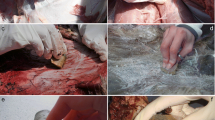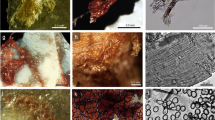Abstract
In lithic residue analysis, the identification of degraded animal tissues on stone tools is challenging due to many factors, not least of which is the fact that residues are complex, heterogeneous mixtures of many different kinds of molecules. In order to aid in their identification, a reference library of infrared spectra of residues collected using Fourier-transform infrared microspectroscopy (FTIRM) has recently been published (Monnier et al J Archaeol Sci: Rep 18:806–823, 2018). The goal of the present study is to explore the effects of decomposition on residues. Accordingly, we buried flakes with residues in compost for 1 year, then excavated them and documented both their appearance (using visible-light microscopy (VLM) and scanning electron microscopy (SEM)) and molecular composition (using FTIRM). The results show that while some residues (like meat and blood) disappeared entirely, others (fat and skin) were preserved on the bottoms of flakes buried in deep layers within the compost. Although the residues were damaged by microbial activity, their FTIRM spectra were clearly interpretable. Residues containing hydroxyapatite (bone and fish scales) and keratin (feather barbules, hair, and skin) were relatively well preserved. Their structures were in many cases recognizable, and their FTIRM spectra were entirely consistent with the FTIRM spectra of the standards. The results of the experiment show that the decay of animal tissues in compost proceeds primarily as a result of microbial activity, which appears to remove the tissues before they have a chance to oxidize or experience other biochemical changes. We conclude that if ancient residues have not been removed by microbial action, they can be identified using FTIR standards based upon fresh residues, such as those published in Monnier et al J Archaeol Sci 78:158–178, (2017), Monnier et al. 2018, J Archaeol Method Theory 25(1):1-44.





















Similar content being viewed by others
References
Anderson PC (1980) A testimony of prehistoric tasks: diagnostic residues on stone tool working edges. World Archaeol 12:181–193
Bordes L, Prinsloo LC, Fullagar R, Sutikna T, Hayes E, Jatmiko, Wahyu Saptomo E, Tocheri M, Roberts RG (2017) Viability of Raman microscopy to identify micro-residues related to tool-use and modern contaminants on prehistoric stone artefacts. J Raman Spectrosc 48(9):1212–1221. https://doi.org/10.1002/jrs.5202
Bordes L, Fullagar R, Prinsloo LC, Hayes E, Kozlikin MB, Shunkov MV, Derevianko AP, Roberts RG (2018) Raman spectroscopy of lipid micro-residues on Middle Palaeolithic stone tools from Denisova Cave, Siberia. J Archaeol Sci 95(July):52–63. https://doi.org/10.1016/j.jas.2018.05.001
Borel A, Olle A, Maria Verges J, Sala R (2014) Scanning electron and optical light microscopy: two complementary approaches for the understanding and interpretation of usewear and residues on stone tools. J Archaeol Sci 48:46–59. https://doi.org/10.1016/j.jas.2013.06.031
Cesaro SN, Lemorini C (2012) The function of prehistoric lithic tools: a combined study of use-wear analysis and FTIR microspectroscopy. Spectrochim Acta Part A Mol Biomol Spectrosc 86:299–304. https://doi.org/10.1016/j.saa.2011.10.040
Charrie-Duhaut A, Porraz G, Cartwright CR, Igreja M, Connan J, Poggenpoel C, Texier P-J (2013) First molecular identification of a hafting adhesive in the Late Howiesons Poort at Diepkloof Rock Shelter (Western Cape, South Africa). J Archaeol Sci 40(9):3506–3518. https://doi.org/10.1016/j.jas.2012.12.026
Croft S, Chatzipanagis K, Kröger R, & Milner N (2018) Misleading residues on lithics from Star Carr: Identification with Raman microspectroscopy. Journal of Archaeological Science: Reports 19(November 2017):430–438. https://doi.org/10.1016/j.jasrep.2018.03.018
Croft S, Monnier G, Radini A, Little A, Milner N (2016) Lithic residue survival and characterisation at star carr: a burial experiment. Internet Archaeol (42). https://doi.org/10.11141/ia.42.5
Forbes SL, Dent BB, Stuart BH (2005). The effect of soil type on adipocere formation. Forensic Sci Int (154):35–43.
Forbes SL, Stuart BH, Dent BB (2005b) The effect of the burial environment on adipocere formation. Forensic Sci Int 154(1):24–34. https://doi.org/10.1016/j.forsciint.2004.09.107
Hayes E, Rots V (2018) Documenting scarce and fragmented residues on stone tools: an experimental approach using optical microscopy and SEM-EDS. Archaeol Anthropol Sci 11:3065–3099. https://doi.org/10.1007/s12520-018-0736-1
Hayes E, Cnuts D, & Rots V. (2019). Integrating SEM-EDS in a sequential residue analysis protocol: benefits and challenges. J Archaeol Sci Rep, 23(August 2018), 116–126. https://doi.org/10.1016/j.jasrep.2018.10.029
Heaton K, Solazzo C, Collins MJ, Thomas-Oates J, Bergström ET (2009) Towards the application of desorption electrospray ionisation mass spectrometry (DESI-MS) to the analysis of ancient proteins from artefacts. J Archaeol Sci 36(10):2145–2154. https://doi.org/10.1016/j.jas.2009.05.016
Hortola P (2001) Experimental SEM determination of game mammalian bloodstains on stone tools. Environ Archaeol 6:97–102
Jahren AH, Toth N, Schick K, Clark JD, Amundson RG (1997) Determining stone tool use: chemical and morphological analyses of residues on experimentally manufactured stone tools. J Archaeol Sci 24:245–250
Lange L, Huang Y, Busk PK (2016) Microbial decomposition of keratin in nature—a new hypothesis of industrial relevance. Appl Microbiol Biotechnol 100(5):2083–2096. https://doi.org/10.1007/s00253-015-7262-1
Langejans GHJ (2010) Remains of the day-preservation of organic micro-residues on stone tools. J Archaeol Sci 37(5):971–985. https://doi.org/10.1016/j.jas.2009.11.030
Lynch V, Miotti L (2017) Introduction to micro-residues analysis: systematic use of scanning electron microscope and energy dispersive X-rays spectroscopy (SEM-EDX) on Patagonian raw materials. J Archaeol Sci Rep 16:299–308
Monnier GF (2018) A review of infrared spectroscopy in microarchaeology: methods, applications, and recent trends. J Archaeol Sci Rep 18(November 2017):806–823. https://doi.org/10.1016/j.jasrep.2017.12.029
Monnier GF, Ladwig JL, Porter ST (2012) Swept under the rug: the problem of unacknowledged ambiguity in lithic residue identification. J Archaeol Sci 39(10):3284–3300. https://doi.org/10.1016/j.jas.2012.05.010
Monnier GF, Hauck TC, Feinberg JM, Luo B, Le Tensorer J-M, al Sakhel H (2013) A multi-analytical methodology of lithic residue analysis applied to Paleolithic tools from Hummal, Syria. J Archaeol Sci 40(10):3722–3739. https://doi.org/10.1016/j.jas.2013.03.018
Monnier G, Frahm E, Luo B, Missal K (2017) Developing FTIR microspectroscopy for analysis of plant residues on stone tools. J Archaeol Sci 78:158–178. https://doi.org/10.1016/j.jas.2016.12.004
Monnier G, Frahm E, Luo B, Missal K (2018) Developing FTIR microspectroscopy for the analysis of animal-tissue residues on stone tools. J Archaeol Method Theory 25(1):1–44. https://doi.org/10.1007/s10816-017-9325-3
Olsen SL (1988) Scanning electron microscopy in archaeology. BAR International Series, Oxford, p 452
Pawlik AF (2004). Identification of hafting traces and residues by scanning electron microscopy and energy-dispersive analysis of X-rays. In Walker EA, Wenban-Smith F, & Healy F (eds.), Lithics in action: papers from the Conference Lithic Studies in the Year 2000, Oxbow Books, pp. 169–182
Pedergnana A, Ollé A (2018) Building an experimental comparative reference collection for lithic micro-residue analysis based on a multi-analytical approach. J Archaeol Method Theory 25(1):117–154. https://doi.org/10.1007/s10816-017-9337-z
Pedergnana A, Asryan L, Fernández-Marchena JL, Ollé A (2016) Modern contaminants affecting microscopic residue analysis on stone tools: a word of caution. Micron 86:1–21
Perrault K, Stefanuto P-H, Dubois L, Cnuts D, Rots V, Focant J-F (2016) A new approach for the characterization of organic residues from stone tools using GC × GC-TOFMS. Separations 3(2):16. https://doi.org/10.3390/separations3020016
Prinsloo LC, Wadley L, Lombard M (2014) Infrared reflectance spectroscopy as an analytical technique for the study of residues on stone tools: potential and challenges. J Archaeol Sci 41:732–739. https://doi.org/10.1016/j.jas.2013.10.011
Solodenko N, Zupancich A, Cesaro SN, Marder O, Lemorini C, Barkai R (2015) Fat residue and use-wear found on Acheulian biface and scraper associated with butchered elephant remains at the site of Revadim, Israel. PLoS One 10(3):UNSP e0118572. https://doi.org/10.1371/journal.pone.0118572
Stephenson B (2015) A modified Picro-Sirius Red (PSR) staining procedure with polarization microscopy for identifying collagen in archaeological residues. J Archaeol Sci 61:235–243. https://doi.org/10.1016/j.jas.2015.06.007
Verges JM, Olle A (2011) Technical microwear and residues in identifying bipolar knapping on an anvil: experimental data. J Archaeol Sci 38(5):1016–1025. https://doi.org/10.1016/j.jas.2010.11.016
Wadley L, Lombard M, Williamson B (2004) The first residue analysis blind tests: results and lessons learnt. J Archaeol Sci 31(11):1491–1501. https://doi.org/10.1016/j.jas.2004.03.010
Weiner S (2010) Microarchaeology: beyond the visible archaeological record. Cambridge University Press, Cambridge
Zupancich A, Nunziante-Cesaro S, Blasco R, Rosell J, Cristiani E, Venditti F, Lemorini C, Barkai R, Gopher A (2016) Early evidence of stone tool use in bone working activities at Qesem Cave Israel. Sci Rep 6(October):37686. https://doi.org/10.1038/srep37686
Acknowledgements
This work was funded by NSF grant # BCS-1420702. It was carried out at the University of Minnesota in the Evolutionary Anthropology Laboratories (College of Liberal Arts); at the Advanced Imaging Service for Objects and Spaces (AISOS) in the College of Liberal Arts; at the Characterization Facility (College of Science and Engineering), which receives partial support from the NSF through the MRSEC program; and at LacCore: National Lacustrine Core Facility (College of Science and Engineering), which receives partial support from the NSF. We wish to thank the many people at these centers who helped us along the way: Gil Tostevin, Matt Edling, Samantha Porter, Colin McFadden, Bing Luo, Kristina Brady Shannon, and Amy Myrbo. Many thanks go to Edward Idarraga for his help with the figures, and we thank two anonymous reviewers for their helpful comments.
Author information
Authors and Affiliations
Contributions
The study was designed and implemented by GM; photographs, VLM images, and SEM images were collected by GM and KM; FTIRM spectra were collected by GM; data analysis, manuscript writing, and figures were accomplished by GM.
Corresponding author
Additional information
Publisher’s note
Springer Nature remains neutral with regard to jurisdictional claims in published maps and institutional affiliations.
Electronic supplementary material
ESM 1
(PDF 880 kb)
Rights and permissions
About this article
Cite this article
Monnier, G., May, K. Documenting the degradation of animal-tissue residues on experimental stone tools: a multi-analytical approach. Archaeol Anthropol Sci 11, 6803–6827 (2019). https://doi.org/10.1007/s12520-019-00941-1
Received:
Accepted:
Published:
Issue Date:
DOI: https://doi.org/10.1007/s12520-019-00941-1




